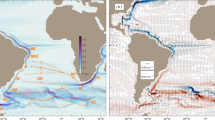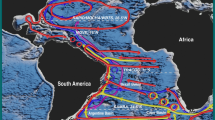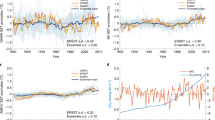Abstract
The Atlantic meridional overturning circulation carries warm upper waters into far-northern latitudes and returns cold deep waters southward across the Equator1. Its heat transport makes a substantial contribution to the moderate climate of maritime and continental Europe, and any slowdown in the overturning circulation would have profound implications for climate change. A transatlantic section along latitude 25° N has been used as a baseline for estimating the overturning circulation and associated heat transport2,3,4. Here we analyse a new 25° N transatlantic section and compare it with four previous sections taken over the past five decades. The comparison suggests that the Atlantic meridional overturning circulation has slowed by about 30 per cent between 1957 and 2004. Whereas the northward transport in the Gulf Stream across 25° N has remained nearly constant, the slowing is evident both in a 50 per cent larger southward-moving mid-ocean recirculation of thermocline waters, and also in a 50 per cent decrease in the southward transport of lower North Atlantic Deep Water between 3,000 and 5,000 m in depth. In 2004, more of the northward Gulf Stream flow was recirculating back southward in the thermocline within the subtropical gyre, and less was returning southward at depth.
This is a preview of subscription content, access via your institution
Access options
Subscribe to this journal
Receive 51 print issues and online access
$199.00 per year
only $3.90 per issue
Buy this article
- Purchase on Springer Link
- Instant access to full article PDF
Prices may be subject to local taxes which are calculated during checkout


Similar content being viewed by others
References
Bryden, H. L. & Imawaki, S. in Ocean Circulation and Climate (eds Siedler, G., Church, J. & Gould, J.) Ch. 6.2 455–474 (Academic, London, 2001)
Hall, M. M. & Bryden, H. L. Direct estimates and mechanisms of ocean heat transport. Deep-Sea Res. 29, 339–359 (1982)
Roemmich, D. & Wunsch, C. Two transatlantic sections: meridional circulation and heat flux in the subtropical North Atlantic Ocean. Deep-Sea Res. 32, 619–664 (1985)
Lavín, A., Bryden, H. L. & Parrilla, G. Meridional transport and heat flux variations in the subtropical North Atlantic. Glob. Atmos. Ocean Syst. 6, 269–293 (1998)
Cubasch, U. et al. in Climate Change 2001: The Scientific Basis (ed. Houghton, J. T.) Ch. 9, 525–582 (Cambridge Univ. Press, Cambridge, UK, 2001)
Vellinga, M. & Wood, R. A. Global climatic impacts of a collapse of the Atlantic thermohaline circulation. Clim. Change 54, 251–267 (2002)
Srokosz, M. New experiment deploys observing array in N. Atlantic to investigate rapid climate change. Eos 85(8), 78–83 (2004)
Cunningham, S. A. RRS Discovery Cruise 279 (04 Apr–10 May 2004): A Transatlantic Hydrography Section at 24.5° N Cruise Report 54, 1–199 (Southampton Oceanography Centre, Southampton, 2005) http://eprints.soton.ac.uk/17527/
Fuglister, F. C. Atlantic Ocean Atlas of Temperature and Salinity Profiles and Data from the International Geophysical Year of 1957–1958. Woods Hole Oceanographic Institution Atlas Series 1, 1–209 (WHOI, Woods Hole, Massachusetts, 1960)
Parrilla, G., Lavín, A., Bryden, H., Garcia, M. & Millard, R. Rising temperatures in the subtropical North Atlantic Ocean over the past 35 years. Nature 369, 48–51 (1994)
Baringer, M. O'N. & Molinari, R. Atlantic Ocean baroclinic heat flux at 24 to 26° N. Geophys. Res. Lett. 26, 353–356 (1999)
Baringer, M. O'N. & Larsen, J. C. Sixteen years of Florida Current transport at 27° N. Geophys. Res. Lett. 28, 3179–3182 (2001)
Bryden, H. L., Johns, W. E. & Saunders, P. M. Deep western boundary current east of Abaco: Mean structure and transport. J. Mar. Res. 63, 35–57 (2005)
Gill, A. E. & Niiler, P. P. The theory of the seasonal variability in the ocean. Deep-Sea Res. 20, 141–177 (1973)
Jayne, S. R. & Marotzke, J. The dynamics of ocean heat transport variability. Rev. Geophys. 39, 385–411 (2001)
Larsen, J. C. Transport and heat flux of the Florida Current at 27° N derived from cross-stream voltages and profiling data: theory and observations. Phil. Trans. R. Soc. Lond. A 338, 169–236 (1992)
Schmitz, W. J. Jr & Richardson, W. S. On the transport of the Florida current. Deep-Sea Res. 15, 679–693 (1968)
Richardson, W. S., Schmitz, W. J. Jr & Niiler, P. P. The velocity structure of the Florida Current from the Straits of Florida to Cape Fear. Deep-Sea Res. 16 (suppl.), 225–231 (1969)
Niiler, P. P. & Richardson, W. S. Seasonal variability of the Florida Current. J. Mar. Res. 31, 144–167 (1973)
Meinen, C. S., Baringer, M. O. & Garcia, R. Florida Current Transport http://www.aoml.noaa.gov/phod/floridacurrent (NOAA/AOML, Miami, Florida, 2005)
Josey, S. & Grist, J. The NOC (formerly SOC) Air-Sea Flux Climatology http://www.noc.soton.ac.uk/JRD/MET/fluxclimatology.php (National Oceanography Centre, Southampton, 2005)
Woodruff, S. NCEP Real-time Marine Data http://www.cdc.noaa.gov/cdc/data.nmc.marine.html (NOAA/Climate Diagnostics Center, Boulder, Colorado, 2005)
Wijffels, S. E., Schmitt, R. W., Bryden, H. L. & Stigebrandt, A. Transport of freshwater by the oceans. J. Phys. Oceanogr. 22, 155–162 (1992)
Trenberth, K. E., Large, W. G. & Olson, J. G. The mean annual cycle in global ocean wind stress. J. Phys. Oceanogr. 20, 1742–1760 (1990)
Leaman, K. D. et al. Transport, potential vorticity, and current/temperature structure across Northwest Providence and Santaren Channels and the Florida Current off Cay Sal Bank. J. Geophys. Res. 100, 8561–8569 (1995)
Ganachaud, A. Error budget of inverse box models: The North Atlantic. J. Atmos. Ocean. Technol. 20, 1641–1655 (2003)
Häkkinen, S. & Rhines, P. B. Decline of subpolar North Atlantic circulation during the 1990s. Science 304, 555–559 (2004)
Østerhus, S. & Gammelsrod, T. The abyss of the Nordic Seas is warming. J. Clim. 12, 3297–3304 (1999)
Dickson, B. et al. Rapid freshening of the deep North Atlantic Ocean over the past four decades. Nature 416, 832–837 (2002)
Hansen, B., Turrell, W. R. & Østerhus, S. Decreasing outflow from the Nordic seas into the Atlantic Ocean through the Faroe Bank channel since 1950. Nature 411, 927–930 (2001)
Acknowledgements
The 2004 transatlantic hydrographic section along 25° N was supported by the Natural Environment Research Council as part of the Core Strategic Research Programme ‘Ocean Variability and Climate’ at Southampton Oceanography Centre. Analysis of the five sections along 25° N was also supported by NERC as part of the Rapid Programme. Comments on an earlier draft by J. Hirschi, W. Johns, S. Josey, C. Meinen, G. Parrilla, P. Rhines, P. Saunders, J. Toole, P. Vélez and R. Wood led to substantial improvement. Author Contributions All authors contributed equally to this work.
Author information
Authors and Affiliations
Corresponding author
Ethics declarations
Competing interests
Reprints and permissions information is available at npg.nature.com/reprintsandpermissions. The authors declare no competing financial interests.
Supplementary information
Supplmentary Figure 1
Cumulative mid-ocean geostrophic transport for the 1957, 1981, 1992, 1998 and 2004 hydrographic sections along 25°N. (PDF 1962 kb)
Supplementary Figure 2
Cumulative mid-ocean geostrophic transport in the upper 1000 m for the 1957, 1981, 1992, 1998 and 2004 hydrographic sections along 25°N. (PDF 5827 kb)
Supplementary Figure 3
Accumulated meridional transport (Sv) above 1000 m depth as a function of zonal distance from the African coast for each of the 5 sections in 1957, 1981, 1992, 1998 and 2004. (PDF 3312 kb)
Supplementary Figure Legends
Text to accompany the above Supplementary Figures. (DOC 23 kb)
Supplementary Table 1
Mid-ocean meridional geostrophic water mass transports (Sv) across 26°N in potential temperature (θ) classes (DOC 32 kb)
Rights and permissions
About this article
Cite this article
Bryden, H., Longworth, H. & Cunningham, S. Slowing of the Atlantic meridional overturning circulation at 25° N. Nature 438, 655–657 (2005). https://doi.org/10.1038/nature04385
Received:
Accepted:
Issue Date:
DOI: https://doi.org/10.1038/nature04385
This article is cited by
-
Increased Asian aerosols drive a slowdown of Atlantic Meridional Overturning Circulation
Nature Communications (2024)
-
The weakening AMOC under extreme climate change
Climate Dynamics (2024)
-
North Atlantic Oscillation impact on the Atlantic Meridional Overturning Circulation shaped by the mean state
npj Climate and Atmospheric Science (2023)
-
Likely accelerated weakening of Atlantic overturning circulation emerges in optimal salinity fingerprint
Nature Communications (2023)
-
The evolution of the North Atlantic Meridional Overturning Circulation since 1980
Nature Reviews Earth & Environment (2022)
Comments
By submitting a comment you agree to abide by our Terms and Community Guidelines. If you find something abusive or that does not comply with our terms or guidelines please flag it as inappropriate.



